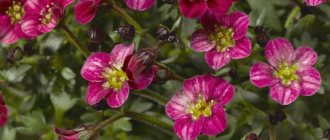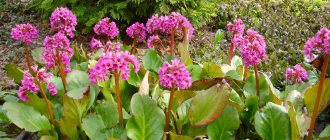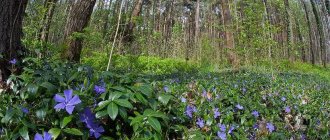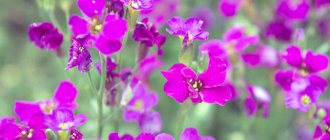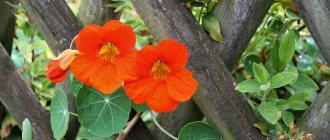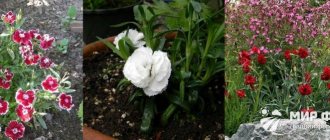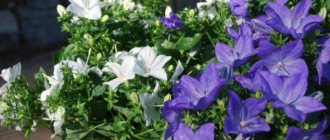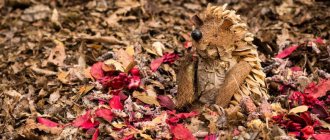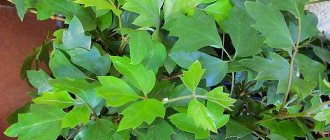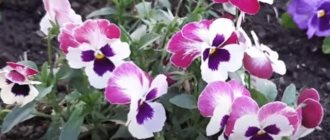Carnation is one of the few universal flowers that is considered appropriate to present to both women and men. In the same way, it is widely used in landscape design: it is grown in flower beds and flower beds, as a solo plant or a background element, as a member of a rock garden and as a tub plant, etc. Another advantage of this ornamental crop is that it is perennial, and caring for and planting it is not difficult and does not require special skills and knowledge.
Having familiarized yourself with the standard growing requirements, you can create a wonderful composition of these flowers on your site, which will delight you with its beauty for many seasons.
General information about the plant
Many species are cultivated as ornamental plants: carnations are used in landscape design and in bouquets. Dianthus is classified as a herb and sometimes as a low-growing shrub.
Leaves are linear or linear-lanceolate. The flowers are often solitary, with 5 petals, 2 styles, 10 stamens and a cylindrical calyx. There are types of carnations whose flowers are collected in inflorescences. Petals come in a wide variety of shapes: smooth, corrugated, fringed, with a torn or wavy edge.
The stem is smooth and knotty, green, blue or bluish in color. Depending on the variety, the length of the stem varies from 5 to 100 cm. The fruit is a cylindrical capsule with black oval seeds.
Annual Chianti carnation
The stem of the carnation is distinguished by two types of shoots: flowering and vegetative, which are much shorter than the first.
The variety of colors is constantly increasing thanks to hybrid varieties. In addition to the classic scarlet carnation, you can find pink, lilac, white and even green flowers. Multi-colored and velvety varieties of all shades of the rainbow seem especially impressive.
Carnation blooms from early summer to late autumn. Many species emit a characteristic pleasant aroma.
general description
The plant's homeland is the warm territories of Europe, North Africa and Asia. The culture combines annual, biennial and perennial varieties, which reproduce with great success and conquer new territories without displacing their neighbors.
There are tall forms, but they are mostly grown for cutting, while garden forms are smaller in height, but wider in diameter, which allows the formation of a larger number of buds. A characteristic feature is long flowering even in the hottest time - from June to September-October. Most varieties are herbaceous forms, but semi-lignified forms can also be found in the wild.
The advantage of perennial carnations is that every year it increases the size of the clump and, accordingly, the number of inflorescences. The height of vegetative shoots does not exceed 1 m. The number of petals in natural species is five; in hybrids and artificially bred varieties it can be much higher. The varied shape of the petals - fringed, corrugated, wavy, rounded - makes each variety unique. The color variety is also striking: yellow, green, purple, creamy orange, red, blue flowers look very colorful and bright.
During flowering, the plant emits a pleasant aroma that fills the garden. After the flowers wither, seed pods with a large number of seeds inside appear in place of the buds.
History, legends about carnations
The earliest information about cloves is found in the myths of Ancient Greece, after which mention of it disappears for 12 centuries. Some historians believe that it was the Crusaders who first brought the flower to Europe as a cure for the plague and a symbol of victory. During Napoleon's time, the color of the carnation was chosen for the ribbon of the Legion of Honor.
European artists of the 16th century made carnations an integral part of portraits and still lifes. The flower is mentioned in Shakespeare's play The Winter's Tale. Queen Elizabeth introduced the fashion for carnations in England.
Bouquet of carnations
The carnation is one of the symbols of the Soviet era. Soviet citizens carried red bouquets to demonstrations dedicated to the day of the October Revolution. For more than 70 years in the CIS countries, the carnation has remained a symbol of victory in the Great Patriotic War.
Variety of species
In landscape design, garden carnations are harmonious both in group and single compositions. Some varieties are even suitable for alpine slides and rockeries; They are planted along borders and dry streams. Garden carnations are often grown in mixborders in the places vacated by early bulbous bulbs. Large-flowered species can become the basis of a flower arrangement, especially surrounded by greenery or against the background of conifers. This versatility is possible due to the existence of a large number of varieties.
Travyanka
Herbaceous perennial, common in Ukraine, Belarus and most of Russia; found even in Siberia and the Far East. In nature, it often settles on sandy soils along rivers or on forest edges, and is found along roads. The bushes are compact, about 25 cm in height. The leaves are small, narrow-linear, dark green. The flowers are small, with fringed petals in white, pinkish or purple shades. It blooms mainly in summer, but can re-shoot buds in early autumn. Based on this variety, many ground cover varieties with bright colors and different flowering periods have been created.
Alpine carnation
This variety is easily identified by its fluffy, squat and wide bushes up to 25 cm high. The leaves are medium-sized, narrow-lanceolate, bluish-green. The petals are jagged, corrugated, predominantly pinkish, lilac, and reddish in color. The first wave of flowering occurs in June–July, the second at the end of August. Under natural conditions, it prefers to settle in mountainous areas on limestone rocks. Found in the Alps, mountains of Slovenia, Italy and Austria. In gardening it is used to decorate alpine slides, dry streams and rockeries.
Turkish cloves
Turkish carnation, also known as bearded carnation, is one of the most common species. It is distinguished by its unpretentiousness, bright, abundant and long-lasting flowering, and a pronounced “clove” aroma. In nature, it prefers to settle on rocky slopes at forest edges or along pebble-strewn river beds.
This herbaceous perennial is easily identified by its bluish, rounded stems and rough, lanceolate leaves. Inflorescences are corymbose, up to 12 cm in diameter. The color is bright, contrasting; White, pinkish and reddish, even dark burgundy, shades predominate. Petals are bicolored or tricolored, often with a border.
Turkish carnation blooms in the second year; grown as a biennial. Easily regenerated from seeds. Every year, many varieties appear that differ in the shape of the petals, doubleness, color, size of the bush and inflorescences, and even smell.
We recommend reading
Rules for planting petunias for seedlings: when to plant, care
Features of growing and propagating hostas, planting and care
Growing Chinese carnation from seeds, care
Planting and caring for galadioli in open ground and pots
Dianthus knappa
Knappa differs from other carnations in the bright yellow color of its petals. Rarely seen. The shape and smell of the inflorescences are similar to Turkish cloves. The bushes are compact, up to 35 cm in height; shoots and leaves are grayish-green. Knapp carnation is grown as a biennial and blooms in its second year from July to August. Frost-resistant, but extremely intolerant of waterlogging. It is found naturally only in Romania and Hungary.
Shabo
Garden carnation shabot is one of the large-flowered varieties, often grown for cutting. Flowers are solitary, up to 7 cm in diameter, double or semi-double; with corrugated, deeply dissected petals of pinkish, yellowish or reddish shades. Blooms from mid-summer until frost. The root system, unlike most carnations, is taprooted and strong. Shoots can reach 60 cm. The leaves are opposite, linear, bluish-green, up to 12 cm in length.
The species was bred artificially and is not found in nature. It is cultivated everywhere, used not only in amateur, but also in industrial gardening for landscaping parks and recreation areas. It has many varieties and hybrids, differing in the shape and color of the petals.
Dianthus pinnata
It is a neat compact bush up to 30 cm. The leaves of the carnation pinnate are bright green, with clearly defined longitudinal veins, which gives them a resemblance to feathers. The flowers are small, up to 3 cm, with a fringed dissected edge. The color spectrum is wide. The buds open en masse throughout June and July. In nature, it prefers calcareous soils of the European foothills.
Dutch carnation
Artificially bred species. Flowering is abundant and long-lasting, from the beginning of summer until frost; in greenhouse conditions it produces buds all year round. It is of industrial importance and is widely grown for cutting. The shoots are dense, rounded, reaching 80 cm in height. The flowers are double or semi-double, often solitary. Many varieties have been bred with a variety of petal colors; white, reddish, pinkish, cream shades predominate.
Chinese carnation
Chinese carnation, or, as it is also called, Amur carnation, grows mainly in Siberia, Primorye or the Far East on sandy or pebble slopes, and is found in meadows. It reaches a height of 40-45 cm. The shoots branch well; leaves are lanceolate, pointed. Flowers up to 2.5 cm, can be pinkish, white, violet, lilac or red.
Biennial, but blooms already in the first year of life, from June to the end of August. Chinese carnation is a winter-hardy variety. Based on it, several popular hybrid series have been developed, the most famous of which is the garden carnation Lillipot. Its dwarf bushes can even be grown on windowsills. There are different colors, including white, reddish, pinkish, carmine; usually sold as a mix of seeds.
Seeds and seedlings
Seeds of annual plants are planted in boxes in early spring. Carnation seedlings will appear in 2-3 months, but only with the onset of warm weather are the seedlings placed in open ground. Turkish and Shabo carnations are sown in February, and perennial garden plants in March.
Biennials such as Turkish and Grenadine are planted in open ground in May, but these plants will bloom only the following summer.
Seeds
To plant seeds, you will need containers with a moist substrate of soil and sand in a 2:1 ratio. Due to the small size of the seeds, they are sown on the surface of the soil and lightly crushed with earth, moistening the substrate with a spray bottle. A weak solution of potassium permanganate will help protect seeds from fungal diseases. The containers are covered with polyethylene and placed in a warm, bright place. When the seeds sprout, the greenhouses are opened.
Seedlings are planted in small pots at a distance of at least 5 cm from each other , watered periodically and ensure that the ambient temperature does not fall below 20 °C. Lower air temperatures slow down seedlings.
Other options
Where does carnation grow without problems? Most often they are sown in special pots. They must be filled with special sand-based soil. The procedure is usually performed at the end of April or beginning of May. It is necessary to constantly carry out special care for cloves. Particular attention is paid to the temperature regime of the soil. In order for the seeds to germinate, the soil is heated to an average of 18°C.
Using pots is a practical way to allow plants to grow stronger. After the carnation seedlings have leaves (from 4 pairs), you can act: either transplant them into a large container, or use a shrub.
The place of permanent growth is chosen next year. At the same time, experts note that flowers do not like to be located in one place. They gradually lose their qualities and are attacked by weeds, if this is a summer cottage.
The most popular are the carnations that are part of the Shabot group. They are annuals. Chinese carnations are also grown as annuals. They should be sown in containers with prepared substrate in any of the winter months. The optimal temperature for them is 12-15°C.
A combination of the following components is used as a substrate: leaves (1 part), clay-turf soil (2 parts), sand (1 part). Picking is done after the formation of the first leaves, which will grow a little and look like real ones. During replanting, this mixture is used, but additionally a little humus is poured into the substrate as an organic fertilizer. The plant will continue to grow comfortably if the air temperature is around 12°C.
Transplanting carnations is a process that can take a lot of effort and time. However, such expenses will be a joy, as they can give excellent results.
Reproduction by cuttings
All types of perennial carnations are propagated by cuttings; this method is not suitable for annual plants. Cuttings are selected from among well-developed vegetative shoots at the end of May. The length of the cutting should be from 3-9 cm, and the shoot should have at least 6 healthy leaves.
Cuttings of eustoma and carnation
The shoot is cut from the stem under the node using a sharp pruner and the leaves are removed from its lower part. An incision is made along the stem.
The cuttings are placed in a pot with perlite and covered with a jar. If the greenhouse is made correctly, rooting will occur within 3 weeks after planting. Next, you need to prepare a container with calcined sand or perlite and plant the cuttings in it.
Photo gallery
Carnation varieties differ in terms of flowering periods, peduncle length, shape, color and fullness of petals. Low-growing varieties are suitable for planting in rock gardens and along the edges of flower beds
Remontant varieties (their feature is to bloom more than once a year) with a stem length of 60 cm are grown in flower greenhouses and greenhouses for the purpose of subsequent sale. There are also low-growing varieties with a stem length of less than 35 cm. An intermediate position is occupied by medium-sized varieties (stem length 35-60 cm), which are convenient to grow on a balcony or in a flower bed. Dwarf remontant varieties feel great in pots.
Reproduction by layering and dividing the bush
The method is suitable for propagation of large species.
A longitudinal incision is made at the internode of strong lower shoots, the shoot is bent to the ground and rooted with the incised area. The cuttings are sprinkled with soil and watered. Once roots appear, the plant can be separated and replanted.
Schematic representation of the process
Reproduction by dividing the bush is suitable only for some species, such as Turkish and pinnate.
Selecting a location and preparing the soil for growing perennial carnations
Proper planting of garden carnations is the key to its successful cultivation. She prefers well-lit areas with moderate amounts of direct sunlight. Some species, such as grass and Chinese carnation, tolerate light partial shade.
Garden carnations take root better on neutral or slightly alkaline soils, breathable, with a small sand content. Some, for example, pinnate cloves, are especially sensitive to high acidity and die without additional liming. However, most species grow well on ordinary garden chernozems or loams. The only thing that garden carnations cannot adapt to is stagnant moisture, so they are not planted in lowlands, and the soil is well drained.
A few weeks before planting the seedlings, the soil is dug up using a shovel and weeds are selected. At the same time, rotted compost, dolomite flour or lime are added; if necessary, peat and sand.
Carnations in landscape design
Variegated Chinese and Turkish carnations go well with other flowers in neutral monochrome shades.
Variety Eydangeri
Some useful tips for flower neighbors:
- Roses inhibit the growth of carnations, so flowers are not planted nearby. Arrange them only in cut form.
- It is not recommended to plant carnations next to tulips, since the plants are susceptible to the same diseases.
- Stagnation of moisture in the soil is contraindicated for the crop. Do not plant carnations in low-lying areas or wetlands.
- If you are choosing a low-growing species, choose grass or sand. Low-growing bushes do not exceed 25 cm during the flowering period.
- In a sunny area, the flower will bloom more abundantly and develop faster than in a shaded flowerbed.
- To design a rock garden or rock garden, plant perennial pinnate varieties.
A skillfully selected variety will harmonize well with plants of any type
Bright varieties of Turkish carnations look good next to tall shrubs, without fear of shading.
Rules of care
Carnation care. It is enough to follow a couple of simple rules, and it will be healthy and strong:
- Careful watering.
- Timely proper feeding.
- Weed removal.
- At the end of the flowering period, the buds are cut off to control self-seeding.
Fertilizer and feeding
The first feeding is carried out while the site is being prepared for a new resident. There is no need to add anything else directly during planting. The next time you will need fertilizers is when the buds begin to form - liquid universal fertilizers that do not contain nitrogen and potassium are suitable for this. The last feeding is carried out after trimming the faded buds.
Watering
Moderate watering is the best solution for this crop. For one adult bush, not about half a liter of water, no more. It should be watered in the evening and near the root, if the day did not rain - the perennial carnation will survive a slight drought, but excess dampness will be harmful to it. To immediately prevent water stagnation and avoid weeding, it is best to spend another ten minutes in the morning after watering, loosen the top layer of soil and remove weeds, if any.
Care after flowering
All care after flowering comes down to pruning and removing dead plants from the area. Partly it’s more aesthetically pleasing, partly pathogenic bacteria can begin to multiply in them.
Trimming
After flowering, all bushes are pruned to a level of 10 cm from the ground. This is done so that they do not grow too much, dry grass does not accumulate in which pathogenic fungi can develop, and to avoid uncontrolled self-seeding.
Preparing for winter
Already trimmed plants can either be slightly insulated before the snow falls, or they can be completely transplanted into pots and wintered at home.
Flower pick
Picking takes place in two stages. The first time they dive after the appearance of two normally developed leaves, the second time after four leaves have formed.
Picking is carried out according to the following scheme:
- the soil with young seedlings is watered abundantly;
- small drainage holes are made in the prepared containers, after which they are filled with substrate;
- small depressions are made in the ground for the root system of the seedling; they should be slightly larger than the roots;
- The sprout is moved to a new container and the substrate is slightly compacted.
After the plant adapts, you can use growth stimulants.
Planting a flower for seedlings depending on the region
Taking into account the timing of planting, it is important to take into account the characteristics of the growing regions. Each region has its own climatic characteristics that can affect the period and abundance of flowering.
In the southern regions, the climate is warm, which allows flower growers to receive seedlings earlier, and, therefore, the bushes will bloom faster.
The length of summer also affects the duration of flowering. In the southern regions, you can plant flowers for seedlings both in February and April.
The climate of the central regions is unpredictable and this can affect the carnation. There is no need to rush to sow here. It is better to start planting in March so that the carnation does not outgrow and form buds before it is planted in the soil. If this happens, the carnation takes a long time and has difficulty adapting, which does not have a very good effect on flowering.
But in the northern regions, where summer is late and short, it is better to sow in mid-March and not delay until April. Late shoots will not have time to form buds and will not bloom at all.
ATTENTION! When planting carnations, weather forecasters' forecasts should also be taken into account. In recent years, the climate in the regions has been changing, and the weather can bring unexpected surprises.
Diseases
If not properly cared for, cloves are prone to certain diseases and attacks by certain pests.
Gardeners have to deal with the following infections:
- Rust . This is a consequence of soil waterlogging. In addition to observing the watering regime, it is recommended to apply foliar fertilizers in a timely manner.
- Fusarium . When infected with this type of fungus, the bush is completely affected. The reason is the same - excessive watering. Fungicides are used as part of treatment.
Cloves are susceptible to attack by spider mites . The pest wraps a web around the stems and leaves of the plant, which is why it got its name. A folk remedy helps against this insect - an infusion of onion peels, tobacco or garlic (10 grams per 5 liters of water).
Spider mite under a microscope
mole cricket plants . They begin to fight this pest in the fall. If planting is planned only in the spring, then a hole is dug on the site into which manure is added. The top is covered with film. By spring, pests will gather under the shelter and are immediately destroyed.
Earwigs that feed on the plant are also easy to kill. To do this, collect wet grass near the flower bed. The pest hides in this ball from the heat. After a few days, the grass ball is destroyed along with the insect.
